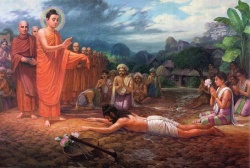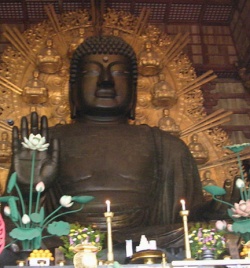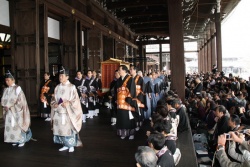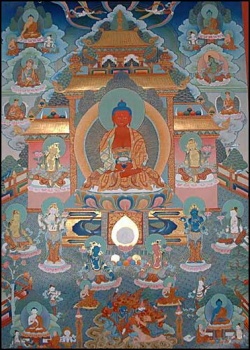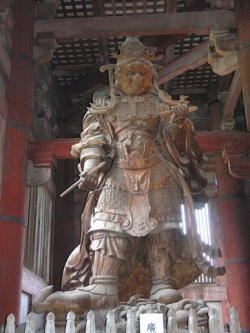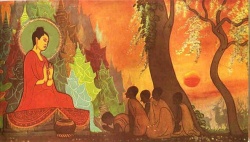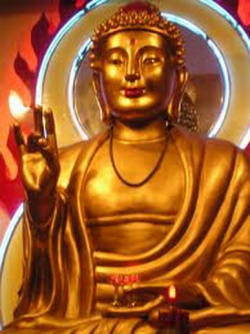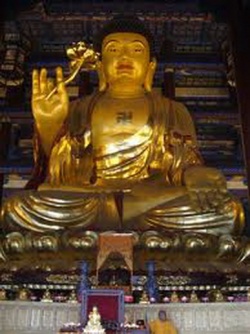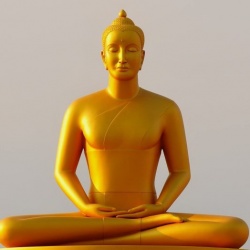Difference between revisions of "Sarvastivada"
| Line 16: | Line 16: | ||
Skt., roughly “the [[teaching]] that says that everything is”; school of the HInayana that split off from the - [[Sthaviras]] under the reign of [[King Ashoka]]. The [[name]] of this school comes from its basic premise that everything - {{Wiki|past}}, {{Wiki|present}}, and {{Wiki|future}} - [[exists]] simultaneously. The [[Sarvastivadin]] school prevailed primarily in [[Kashmir]] and [[Gandhara]]. It constitutes a transitional stage between the - • HInayana and the - [[Mahayana]] . | Skt., roughly “the [[teaching]] that says that everything is”; school of the HInayana that split off from the - [[Sthaviras]] under the reign of [[King Ashoka]]. The [[name]] of this school comes from its basic premise that everything - {{Wiki|past}}, {{Wiki|present}}, and {{Wiki|future}} - [[exists]] simultaneously. The [[Sarvastivadin]] school prevailed primarily in [[Kashmir]] and [[Gandhara]]. It constitutes a transitional stage between the - • HInayana and the - [[Mahayana]] . | ||
| − | The [[Sarvastivadins]] possessed their own [[canon]], composed in [[Sanskrit]], which is partially preserved in {{Wiki|Chinese}} and [[Tibetan]] translation. The most important works of this school are the - [[Abhidharmakosha]] by - [[Vasubandhu]] and the Mahavibhasha (Great {{Wiki|Exegesis}}), which was composed under the supervision of - [[Vasumitra]] at the council of [[Kashmir]] and to which the school owes the [[name]] [[Vaibhashika]], by which it is also known. The Mahavibhasha is a summary of the [[Sarvastivada]] [[teaching]] and is the latest of the seven works of the - [[Abhidharma-pitaka]]. Another important work is the [[Abhidharma]]- [[hridaya]], the [[Heart]] of - [[Abhidharma]] in ten chapters. The Vibhasha by [[Katyayaniputra]] is also a summary of the [[doctrine]]. The [[Loka]] - prajhapti gives a description of the [[mythical]] [[universe]] of [[Buddhism]]. On matters of [[discipline]], only the Vinaya-vibhasha is extant. | + | The [[Sarvastivadins]] possessed their own [[canon]], composed in [[Sanskrit]], which is partially preserved in {{Wiki|Chinese}} and [[Tibetan]] translation. The most important works of this school are the - [[Abhidharmakosha]] by - [[Vasubandhu]] and the [[Mahavibhasha]] (Great {{Wiki|Exegesis}}), which was composed under the supervision of - [[Vasumitra]] at the council of [[Kashmir]] and to which the school owes the [[name]] [[Vaibhashika]], by which it is also known. The [[Mahavibhasha]] is a summary of the [[Sarvastivada]] [[teaching]] and is the latest of the seven works of the - [[Abhidharma-pitaka]]. Another important work is the [[Abhidharma]]- [[hridaya]], the [[Heart]] of - [[Abhidharma]] in ten chapters. The Vibhasha by [[Katyayaniputra]] is also a summary of the [[doctrine]]. The [[Loka]] - prajhapti gives a description of the [[mythical]] [[universe]] of [[Buddhism]]. On matters of [[discipline]], only the Vinaya-vibhasha is extant. |
The [[teaching]] of the [[Sarvastivada]] is a radical {{Wiki|pluralism}} based on {{Wiki|denial}} of the [[reality]] of a [[self]] as a [[substance]] or [[soul]] ( - [[anatman]]) and the [[affirmation]] of the [[existence]] of momentary entities, the so-called - [[dharmas]]. | The [[teaching]] of the [[Sarvastivada]] is a radical {{Wiki|pluralism}} based on {{Wiki|denial}} of the [[reality]] of a [[self]] as a [[substance]] or [[soul]] ( - [[anatman]]) and the [[affirmation]] of the [[existence]] of momentary entities, the so-called - [[dharmas]]. | ||
| Line 101: | Line 101: | ||
A number of theories have been posited by {{Wiki|academics}} as to how the two are {{Wiki|related}}, which [[Bhikkhu]] Sujato summaries as follows: | A number of theories have been posited by {{Wiki|academics}} as to how the two are {{Wiki|related}}, which [[Bhikkhu]] Sujato summaries as follows: | ||
| − | The uncertainty around this school has led to a number of {{Wiki|hypotheses}}. Frauwallner’s {{Wiki|theory}} holds that the [[Mūlasarvāstivāda]] [[Vinaya]] is the disciplinary code of an early [[Buddhist]] {{Wiki|community}} based in {{Wiki|Mathura}}, which was quite {{Wiki|independent}} in its establishment as a [[monastic]] {{Wiki|community}} from the [[Sarvāstivādins]] of {{Wiki|Kaśmir}} (although of course this does not mean that they were different in terms of [[Doctrine]]). Lamotte, opposing Frauwallner, asserts that the [[Mūlasarvāstivāda]] [[Vinaya]] was a late {{Wiki|Kaśmīr}} compilation made to complete the [[Sarvāstivādin]] [[Vinaya]]. Warder suggests that the [[Mūlasarvāstivādins]] were a later development of the [[Sarvāstivāda]], whose main innovations were {{Wiki|literary}}, the compilation of the large [[Vinaya]] and the [[Saddharmasmṛtyupasthāna]] [[Sūtra]], which kept the early [[doctrines]] but brought the style up to date with contemporary {{Wiki|literary}} developments. Enomoto pulls the rug out from all these theories by asserting that [[Sarvāstivādin]] and [[Mūlasarvāstivādin]] are really the same. Meanwhile, Willemen, Dessein, and Cox have developed the {{Wiki|theory}} that the [[Sautrantikas]], a branch or tendency within the [[Sarvāstivādin]] group of schools, emerged in [[Gandhāra]] and {{Wiki|Bactria}} around 200 CE. Although they were the earlier group, they temporarily lost ground to the {{Wiki|Kaśmīr}} [[Vaibhāśika]] school due to the {{Wiki|political}} [[influence]] of [[Kaṇiṣka]]. In later years the [[Sautrantikas]] became known as [[Mūlasarvāstivādins]] and regained the ascendancy. I have elsewhere given my [[reasons]] for disagreeing with the theories of Enomoto and Willemen et al. Neither Warder nor Lamotte give sufficient {{Wiki|evidence}} to back up their theories. We are left with Frauwallner’s {{Wiki|theory}}, which in this [[respect]] has stood the test of [[time]]. | + | The uncertainty around this school has led to a number of {{Wiki|hypotheses}}. Frauwallner’s {{Wiki|theory}} holds that the [[Mūlasarvāstivāda]] [[Vinaya]] is the disciplinary code of an early [[Buddhist]] {{Wiki|community}} based in {{Wiki|Mathura}}, which was quite {{Wiki|independent}} in its establishment as a [[monastic]] {{Wiki|community}} from the [[Sarvāstivādins]] of {{Wiki|Kaśmir}} (although of course this does not mean that they were different in terms of [[Doctrine]]). Lamotte, opposing {{Wiki|Frauwallner}}, asserts that the [[Mūlasarvāstivāda]] [[Vinaya]] was a late {{Wiki|Kaśmīr}} compilation made to complete the [[Sarvāstivādin]] [[Vinaya]]. Warder suggests that the [[Mūlasarvāstivādins]] were a later development of the [[Sarvāstivāda]], whose main innovations were {{Wiki|literary}}, the compilation of the large [[Vinaya]] and the [[Saddharmasmṛtyupasthāna]] [[Sūtra]], which kept the early [[doctrines]] but brought the style up to date with contemporary {{Wiki|literary}} developments. Enomoto pulls the rug out from all these theories by asserting that [[Sarvāstivādin]] and [[Mūlasarvāstivādin]] are really the same. Meanwhile, Willemen, Dessein, and Cox have developed the {{Wiki|theory}} that the [[Sautrantikas]], a branch or tendency within the [[Sarvāstivādin]] group of schools, emerged in [[Gandhāra]] and {{Wiki|Bactria}} around 200 CE. Although they were the earlier group, they temporarily lost ground to the {{Wiki|Kaśmīr}} [[Vaibhāśika]] school due to the {{Wiki|political}} [[influence]] of [[Kaṇiṣka]]. In later years the [[Sautrantikas]] became known as [[Mūlasarvāstivādins]] and regained the ascendancy. I have elsewhere given my [[reasons]] for disagreeing with the theories of Enomoto and Willemen et al. Neither Warder nor Lamotte give sufficient {{Wiki|evidence}} to back up their theories. We are left with Frauwallner’s {{Wiki|theory}}, which in this [[respect]] has stood the test of [[time]]. |
[[File:4423es.jpg|thumb|250px|]] | [[File:4423es.jpg|thumb|250px|]] | ||
Details of [[philosophy]] | Details of [[philosophy]] | ||
Revision as of 14:03, 22 March 2014
The Sarvāstivāda (Sanskrit: सर्वास्तिवाद sarvāstivāda; traditional Chinese: 說一切有部; pinyin: Shuō Yīqièyǒu Bù) were an early school of Buddhism that held to 'the existence of all dharmas in the past, present and future, the 'three times'. Vasubandhu's Abhidharmakośa-bhāṣya states:
25c-d. He who affirms the existence of the dharmas of the three time periods [[[Wikipedia:past|past]], present and future] is held to be a Sarvastivadin.
The Sarvāstivādins were one of the most influential Buddhist monastic groups, flourishing throughout Northwest India, Northern India, and [[Wikipedia:Central Asia|Central Asia]]. The Sarvāstivādins are believed to have given rise to the Mūlasarvāstivāda sect, although the relationship between these two groups has not yet been fully determined.
Sarvāstivāda is a Sanskrit term that can be glossed as: "the theory of all exists". The Pali equivalent is Sabbatthivāda.
Although there is some dispute over how the word "sarvāstivāda" is to be analyzed, the general consensus is that it is to be parsed into three parts: sarva "all" or "every" + asti "exist" + vada "speak", "say" or "theory". This equates perfectly with the Chinese term, Shuōyīqièyǒu-bù (說一切有部), which is literally "the sect that speaks of the existence of everything," as used by Xuanzang and other translators.
Origination and history
Skt., roughly “the teaching that says that everything is”; school of the HInayana that split off from the - Sthaviras under the reign of King Ashoka. The name of this school comes from its basic premise that everything - past, present, and future - exists simultaneously. The Sarvastivadin school prevailed primarily in Kashmir and Gandhara. It constitutes a transitional stage between the - • HInayana and the - Mahayana .
The Sarvastivadins possessed their own canon, composed in Sanskrit, which is partially preserved in Chinese and Tibetan translation. The most important works of this school are the - Abhidharmakosha by - Vasubandhu and the Mahavibhasha (Great Exegesis), which was composed under the supervision of - Vasumitra at the council of Kashmir and to which the school owes the name Vaibhashika, by which it is also known. The Mahavibhasha is a summary of the Sarvastivada teaching and is the latest of the seven works of the - Abhidharma-pitaka. Another important work is the Abhidharma- hridaya, the Heart of - Abhidharma in ten chapters. The Vibhasha by Katyayaniputra is also a summary of the doctrine. The Loka - prajhapti gives a description of the mythical universe of Buddhism. On matters of discipline, only the Vinaya-vibhasha is extant.
The teaching of the Sarvastivada is a radical pluralism based on denial of the reality of a self as a substance or soul ( - anatman) and the affirmation of the existence of momentary entities, the so-called - dharmas.
The Sarvastivadins postulate seventy-five different dharmas, which (like the ancient notion of atoms) represent final, indivisible units, viewed as real. They distinguished conditioned ( samskrita) and unconditioned ( - i> asamskrita) dharmas. Among the latter are space ( akasha), - apratishthita-nirvana, and - pratishthita-nirvana.
The conditioned dharmas are divided into four categories: form or matter ( rupa)\ consciousness ( - • vijhana); mental factors ( - • chetasika), meaning all psychological processes; and dharmas, which are neither form nor consciousness, and include, for example, old age, vitality, attainment, nonattainment impermanence, and so on.
According to the Sarvastivadins, these conditioned dharmas do not come into being but rather exist from beginningless time and only change from a latent to a manifest state. From this the view results that “everything is," and that past, present, and future exist simultaneously in a single dharma. In addition, one finds in the Sarvastivada an early form of the Mahayana teaching of the trikaya and the belief, which continued to grow in importance, in the future buddha Maitreya.
According to scholar Charles Prebish,
There is a great deal of mystery surrounding the rise and early development of the Sarvastivadin school. On the one hand, we have the tradition of Asoka’s Council, stating that the schismatic group in The Sangha was expelled from Magadha, migrating to northwestern India and evolving into the Sarvastivadin school. On the other hand, we have the attempts of several scholars to ascribe the rise of the school to one of Asoka’s missions—that sending Majjhantika to Gandhara, an early seat of the school. This episode corresponds well with one Sarvastivadin tradition stating that Madhyantika (the Sanskrit counterpart of the Pali Majjhantika) converted the city of Kasmir, which seems to have close ties with Gandhara. Still another tradition established a community of Sarvastivadin Monks at Mathura, founded by the Patriarch Upagupta. Be that as it may, until the reign of King Kanishka, around the turn of the Christian era, the history of the school is at best sketchy.
The Sarvāstivāda enjoyed the patronage of Kanishka, during which time they were greatly strengthened, and became one of the dominant sects of Buddhism for the next thousand years.
In [[Wikipedia:Central Asia|Central Asia]], several Buddhist monastic groups were historically prevalent. A number of scholars have identified three distinct major phases of missionary activity seen in The History of Buddhism in [[Wikipedia:Central Asia|Central Asia]], which are associated with the following sects, chronologically:
Dharmaguptaka
Sarvāstivāda
Mūlasarvāstivāda
Appearance and Language
Appearance
Between 148 and 170 CE, the Parthian Monk An Shigao came to China and translated a work which described the color of monastic robes (Skt. kāṣāya) utitized in five major Indian Buddhist sects, called Da Biqiu Sanqian Weiyi (大比丘三千威儀). Another text translated at a later date, the Śariputraparipṛcchā, contains a very similar passage with nearly the same Information. In the earlier source, the Sarvāstivāda are described as wearing dark red robes, while the Dharmaguptaka are described as wearing black robes. However, in the corresponding passage found in the later Śariputraparipṛcchā, the Sarvāstivāda are described as wearing black robes and the Dharmaguptaka as wearing dark red robes. In traditions of Tibetan Buddhism, which follow the Mūlasarvāstivāda Vinaya, red robes are regarded as characteristic of their tradition.
Language
The Tibetan historian Buton Rinchen Drub wrote that the Mahāsāṃghikas used Prākrit, the Sarvāstivādins used Sanskrit, the Sthaviravāda used Paiśācī, and the Saṃmatīya used Apabhraṃśa.
Doctrinal systems
The Sarvāstivāda comprised two subschools, the Vaibhāṣika and the Sautrāntika.The pioneering work about the subject was undertaken by Ch. Willemen ever since 1975,and more recently in 2006 (Abhidharmahṛdaya) and in 2008 in the Journal of the International College for Postgraduate Buddhist Studies (Tokyo). The Vaibhāṣika was formed by adherents of the Mahāvibhāṣa Śāstra, comprising the orthodox Kasmiri branch of the Sarvāstivāda school. The Vaibhāśika-Sarvāstivāda, which had by far the most "comprehensive edifice of doctrinal systematics" of the early Buddhist schools, was widely influential in India and beyond. Regarding divisions of practice, the Vaibhāṣika Sarvāstivādins are known to have employed the outlook of Buddhist practice as consisting of the Three Vehicles:
Śrāvakayāna
Pratyekabuddhayāna
Bodhisattvayāna
In contrast to the Vaibhāṣikas, the Sautrāntika Sarvāstivādins did not uphold the Mahāvibhāṣa Śāstra, but rather emphasized the Buddhist sūtras. The name Sautrāntika means "those who uphold the sūtras." According to the Abhidharmakośa-bhāṣya, the Sautrāntikas held the Doctrine that there may be many contemporaneous Buddhas.
According to A.K. Warder, the Sarvāstivādins held the same position as the Mahāsāṃghika branch regarding Arhats, considering them to be imperfect and fallible. In the Sarvāstivādin Nāgadatta Sūtra, the Mahīśāsaka view of women is criticized in a narrative about a bhikṣuṇī named Nāgadatta. Here, the demon Māra takes the Form of her father, and tries to convince her to work toward the lower stage of an Arhat, rather than that of a fully Enlightened Buddha (Skt. samyaksaṃ Buddha).
Māra therefore took the disguise of Nāgadatta's father and said thus to Nāgadatta: "Your Thought is too serious. Buddhahood is too difficult to attain. It takes a hundred thousand nayutas of koṭis of kalpas to become a Buddha. Since few people attain Buddhahood in this World, why don't you attain Arhatship? For the experience of Arhatship is the same as that of Nirvāṇa; moreover, it is easy to attain Arhatship...."
In her reply, Nāgadatta rejects arhatship as a lower path, saying, "A Buddha's Wisdom is like empty space of the ten quarters, which can enlighten innumerable people. But an Arhat's Wisdom is inferior."
Canon
Vinaya
The Dharmaguptaka are known to have rejected the authority of the Sarvāstivāda pratimokṣa rules on the grounds that the original teachings of The Buddha had been lost.
The complete Sarvāstivāda Vinaya is extant in The Chinese Buddhist Canon. In its early history, the Sarvāstivāda Vinaya was the most common Vinaya tradition in China. However, Chinese Buddhism later settled on the Dharmaguptaka Vinaya.
Āgamas
Scholars at present have "a nearly complete collection of sūtras from the Sarvāstivāda school" thanks to a recent discovery in Afghanistan of roughly two-thirds of Dīrgha Āgama in Sanskrit. The Madhyama Āgama (T26, Chinese trans. Gotama Saṅghadeva) and Saṃyukta Āgama (T99, Chinese trans. Guṇabhadra) have long been available in Chinese translation. The Sarvāstivāda is therefore the only early school besides the Theravada for which we have a roughly complete Sutra collection, although unlike the Theravada it has not all been preserved in the original Language.
Abhidharma
The Sarvāstivāda Abhidharma consists of seven texts. The texts of the Sarvāstivādin Abhidharma are:
Sangitiparyaya ('Discourses on Gathering Together')
Dharmaskandha ('Aggregation of Dharmas')
Prajnaptisastra ('Treatise on Designations')
Dhatukaya ('Body of Elements')
Vijnanakaya ('Body of Consciousness')
Prakaranapada ('Exposition')
Jnanaprasthana ('Foundation of Knowledge')
Following these, are the texts that became the authority of the Vaibhashikas, the Kasmiri Sarvastivada Orthodoxy:
Mahavibhasa ("Great Commentary", on the Jnanaprasthana)
Little research on these texts has been published in English.
Relationship to Mahāyāna
The Sarvāstivādins of Kāśmīra held the Mahāvibhāṣā Śāstra as authoritative, and thus were given the moniker of being Vaibhāṣikas. The Mahāvibhāṣā is Thought to have been authored around 150 CE, around the time of Kaniṣka (127–151 CE) of the Kuṣāṇa Empire. This massive treatise of Abhidharma (200 fascicles in Chinese) contains a great deal of material with what appear to be strong affinities to Mahāyāna doctrines. The Mahāvibhāṣā is also said to illustrate the accommodations reached between the Hīnayāna and Mahāyāna traditions, as well as the means by which Mahāyāna doctrines would become accepted. The Mahāvibhāṣā also defines the Mahāyāna sūtras and the role in their Buddhist Canon. Here they are described as Vaipulya doctrines, with "Vaipulya" being a commonly used synonym for Mahāyāna. The Mahāvibhāṣā reads:
What is the Vaipulya? It is said to be all the sūtras corresponding to elaborations on the meanings of the exceedingly profound dharmas.
According to a number of scholars, Mahāyāna Buddhism flourished during the time of the Kuṣāṇa Empire, and this is illustrated in the Form of Mahāyāna influence on the Mahāvibhāṣā Śāstra. The Mañjuśrīmūlakalpa also records that Kaniṣka presided over the establishment of Prajñā pāramitā doctrines in the northwest of India Étienne Lamotte has also pointed out that a Sarvāstivāda master is known to have stated that the Mahāyāna Prajñā sūtras were to be found amongst their Vaipulya sūtras. According to Paul Williams, the similarly massive Mahā Prajñā pāramitā Śāstra also has a clear association with the Vaibhāṣika Sarvāstivādins.
Regarding divisions of practice, the Mahāvibhāṣā Śāstra is known to employ the outlook of Buddhist practice as consisting of the Three Vehicles. References to Bodhisattvayāna and the practice of the Six Pāramitās are commonly found in Sarvāstivāda works as well. The Sarvāstivādins also did not hold that it was impossible, or even impractical to strive to become a fully Enlightened Buddha (Skt. samyaksaṃ Buddha), and therefore they admitted the path of a Bodhisattva as a valid one.
Relationship to Mūlasarvāstivāda
A number of theories have been posited by academics as to how the two are related, which Bhikkhu Sujato summaries as follows:
The uncertainty around this school has led to a number of hypotheses. Frauwallner’s theory holds that the Mūlasarvāstivāda Vinaya is the disciplinary code of an early Buddhist community based in Mathura, which was quite independent in its establishment as a monastic community from the Sarvāstivādins of Kaśmir (although of course this does not mean that they were different in terms of Doctrine). Lamotte, opposing Frauwallner, asserts that the Mūlasarvāstivāda Vinaya was a late Kaśmīr compilation made to complete the Sarvāstivādin Vinaya. Warder suggests that the Mūlasarvāstivādins were a later development of the Sarvāstivāda, whose main innovations were literary, the compilation of the large Vinaya and the Saddharmasmṛtyupasthāna Sūtra, which kept the early doctrines but brought the style up to date with contemporary literary developments. Enomoto pulls the rug out from all these theories by asserting that Sarvāstivādin and Mūlasarvāstivādin are really the same. Meanwhile, Willemen, Dessein, and Cox have developed the theory that the Sautrantikas, a branch or tendency within the Sarvāstivādin group of schools, emerged in Gandhāra and Bactria around 200 CE. Although they were the earlier group, they temporarily lost ground to the Kaśmīr Vaibhāśika school due to the political influence of Kaṇiṣka. In later years the Sautrantikas became known as Mūlasarvāstivādins and regained the ascendancy. I have elsewhere given my reasons for disagreeing with the theories of Enomoto and Willemen et al. Neither Warder nor Lamotte give sufficient evidence to back up their theories. We are left with Frauwallner’s theory, which in this respect has stood the test of time.
Details of philosophy
Though the sarvastivadins would themselves claim that their teaching of ‘all exists’ (sarvasti) is a direct teaching of The Buddha himself, as shown by their attributing the earliest Abhidharma texts to direct disciples of The Buddha, notably to Sariputra and Constant reference to the sutras throughout, the school in its entirety is more rightly to be considered as part of the age of scholastic Buddhism. It was the most influential school in the northwestern part of India. In a Chinese context, the word Abhidharma refers to the sarvastivada Abhidharma, although at a minimum the Dharmaguptaka, Pudgalavada and Theravada also had abhidharmas.
During the first century BC, in the Gandharan cultural area (consisting of Oddiyana, Gandhara and Bactria, Tokharistan, across the Khyber Pass), the sthaviriyas used Gandhari to write their literature in the Kharoṣṭhī script. During this time, the sarvastivada Abhidharma primarily consisted of the Abhidharmahrdaya authored by Dharmashresthin, a native from Tokharistan, and the Ashtagrantha authored/compiled by Katyayaniputra. Both texts were translated by Samghadeva in 391 AD and in 183 AD. respectively, but they were not completed until 390 in Southern China.
Although the sarvastitva was the central thesis, there were different theories on how ‘sarvam’ and even ‘asti’ were actually to be explained and understood among the Gandharan diverse sarvastivadins. Vasubandhu’s Koshabhasya, an elaborate yoga manual based on the Hrdaya, describes four main theses on sarvasti:
There are four types of sarvastivadins accordingly as they teach a difference in existence (bhavanyathatva), a difference in characteristic (laksananyathatva), a difference in condition (avasthanyathatva), and mutual difference (anyonyathatva).
Later sarvastivada takes a combination of the first and third theses as its model. It was on this basis that the school’s doctrines were defended in the face of growing external, and sometimes even internal, Criticism.
The doctrines of sarvastivada were not confined to ‘all exists’, but also include the theory of momentariness (ksanika), conjoining (samprayukta) and simultaneity (sahabhu), conditionality (hetu and pratyaya), the culmination of the spiritual path (marga), and others. These doctrines are all inter-connected and it is the principle of ‘all exists’ that is the axial Doctrine holding the larger movement together when the precise details of other doctrines are at stake.
The sarvastivada was also known by other names, particularly hetuvada and yuktivada. Hetuvada comes from hetu – ‘cause’, which indicates their emphasis on causation and conditionality. Yuktivada comes from yukti – ‘reason’ or even ‘logic’, which shows their use of rational argument and syllogism.
When the sarvastivada school held a synod in Kashmira during the reign of Kanishka II (c. 158-176), the Gandharan most important text, the Astagrantha of Katyayaniputra was rewritten in Sanskrit making necessary revisions. This revised text was now known as Jnanaprasthana, Course of Knowledge. Though the Gandharan Astagrantha had many vibhasas, the new Kashmira Astagrantha i.e. the Jnanaprasthana had a Sanskrit Mahavibhasa, compiled by the Kashmira sarvastivada synod. The Jnanaprasthana and its Mahavibhasa, which took more than a generation to complete, were then declared the Vaibhasika orthodoxy, said to be ‘Buddha’s word’, Buddhabhasita. This new Vaibhasika orthodoxy, however, was not readily accepted by the Gandharan sarvastivadins, though gradually they adapted their views to the new Kasmira orthodoxy. The Gandharan sarvastivadins used the same Vinaya from Mathura. As a matter of fact, their Abhidharma was meant for meditational practices. They made use of the Hrdaya which is a manual for attaining Arhat. However, the long Gandharan Vinaya was abridged to a Sanskrit Dashabhanavara in the Kashmira synod by removing the avadanas and Jatakas, stories and illustrations. After the declaration of the Vaibhasika orthodoxy, the Gandharan non-vaibhasika sarvastivadins, the majority, were called ‘sautrantikas’(those who uphold the sutras).
Interestingly, the Kasmira orthodoxy, the Vaibhasikas disappeared in the later part of the 7th century. Subsequently, the old Gandharan sarvastivadins, the non-vaibhasika sautrantikas, were named ‘mulasarvastivadins’, who then at a later date went to Tibet. It has been suggested that the minority Vaibhasikas were absorbed into the majority sautrantika sarvastivadins as a possible result of the latter’s adaptations.
Moreover, Mishrakabhidharmahrdaya, a title which means that ‘sautrantika views were mixed with vaibhasika views’ was composed by Dharmatrata in the 4th century in Gandharan area. Vasubandhu (ca.350-430), a native from Purusapura in Gandhara, composed his Kosa based on this text and the Astagrantha. While in Kasmira, he wrote his karikas which were well received there but he faced intense opposition, notably from Samghabhadra, a leading sarvastivada pundit, when he composed his bhasya. By his bhasya, Vasubandhu made it clear to the Vaibhasikas that he was a sautrantika, which is why he was fiercely opposed by the sarvastivada vaibhasikas in Kasmira.
In reply to Vasubhandhu’s bhasya, Samghabhadra wrote a text, the Nyayanusara ‘according to reason’. This work is presently only extant in Chinese (from Xuanzang’s translation and little is known of it in English).
For a critical examination of the Sarvastivadin interpretation of the Samyuktagama, see David Kalupahana, Causality: The Central Philosophy of Buddhism. For a Sautrantika refutation of the Sarvastivadin use of the Samyuktagama, see Theodore Stcherbatsky, The Central Conception of Buddhism and the Meaning of the Word Dharma.
